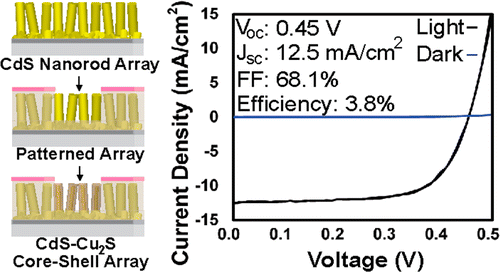当前位置:
X-MOL 学术
›
Nano Lett.
›
论文详情
Our official English website, www.x-mol.net, welcomes your
feedback! (Note: you will need to create a separate account there.)
Core–Shell CdS–Cu2S Nanorod Array Solar Cells
Nano Letters ( IF 9.6 ) Pub Date : 2015-05-20 00:00:00 , DOI: 10.1021/acs.nanolett.5b01203
Andrew Barnabas Wong 1, 2 , Sarah Brittman 1, 2 , Yi Yu 1, 2 , Neil P. Dasgupta 1 , Peidong Yang 1, 2, 3, 4
Nano Letters ( IF 9.6 ) Pub Date : 2015-05-20 00:00:00 , DOI: 10.1021/acs.nanolett.5b01203
Andrew Barnabas Wong 1, 2 , Sarah Brittman 1, 2 , Yi Yu 1, 2 , Neil P. Dasgupta 1 , Peidong Yang 1, 2, 3, 4
Affiliation

|
As an earth-abundant p-type semiconductor, copper sulfide (Cu2S) is an attractive material for application in photovoltaic devices. However, it suffers from a minority carrier diffusion length that is less than the length required for complete light absorption. Core–shell nanowires and nanorods have the potential to alleviate this difficulty because they decouple the length scales of light absorption and charge collection. To achieve this geometry using Cu2S, cation exchange was applied to an array of CdS nanorods to produce well-defined CdS–Cu2S core–shell nanorods. Previous work has demonstrated single-nanowire photovoltaic devices from this material system, but in this work, the cation exchange chemistry has been applied to nanorod arrays to produce ensemble-level devices with microscale sizes. The core–shell nanorod array devices show power conversion efficiencies of up to 3.8%. In addition, these devices are stable when measured in air after nearly one month of storage in a desiccator. These results are a first step in the development of large-area nanostructured Cu2S-based photovoltaics that can be processed from solution.
中文翻译:

核壳CdS-Cu 2 S纳米棒阵列太阳能电池
作为地球上富含p的半导体,硫化铜(Cu 2 S)是用于光伏器件的有吸引力的材料。但是,它的少数载流子扩散长度小于完全吸收光所需的长度。核-壳纳米线和纳米棒具有缓解这一困难的潜力,因为它们使光吸收和电荷收集的长度尺度脱钩。为了使用Cu 2 S实现这种几何形状,将阳离子交换应用于CdS纳米棒阵列,以产生明确的CdS–Cu 2S核-壳纳米棒。先前的工作已经证明了该材料系统的单纳米线光伏器件,但是在这项工作中,阳离子交换化学已应用于纳米棒阵列,以生产具有微米级尺寸的整体级器件。核-壳纳米棒阵列器件显示出高达3.8%的功率转换效率。此外,在干燥器中存放近一个月后,在空气中测量时,这些设备是稳定的。这些结果是开发可从溶液中加工的大面积纳米结构的基于Cu 2 S的光伏电池的第一步。
更新日期:2015-05-20
中文翻译:

核壳CdS-Cu 2 S纳米棒阵列太阳能电池
作为地球上富含p的半导体,硫化铜(Cu 2 S)是用于光伏器件的有吸引力的材料。但是,它的少数载流子扩散长度小于完全吸收光所需的长度。核-壳纳米线和纳米棒具有缓解这一困难的潜力,因为它们使光吸收和电荷收集的长度尺度脱钩。为了使用Cu 2 S实现这种几何形状,将阳离子交换应用于CdS纳米棒阵列,以产生明确的CdS–Cu 2S核-壳纳米棒。先前的工作已经证明了该材料系统的单纳米线光伏器件,但是在这项工作中,阳离子交换化学已应用于纳米棒阵列,以生产具有微米级尺寸的整体级器件。核-壳纳米棒阵列器件显示出高达3.8%的功率转换效率。此外,在干燥器中存放近一个月后,在空气中测量时,这些设备是稳定的。这些结果是开发可从溶液中加工的大面积纳米结构的基于Cu 2 S的光伏电池的第一步。































 京公网安备 11010802027423号
京公网安备 11010802027423号